Henry Aldred (later Aldridge) was born on 18 March 1818 in Leeds, England to parents George Aldred (1785-1844) and Lydia Osterfield (1784-1844). Henry was one of eleven children born to the couple.
Henry was baptised on 23 April 1821 at St Peter, Leeds, Yorkshire.
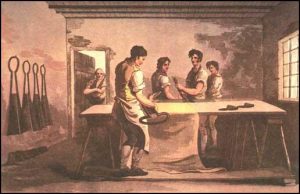
cloth dresser 1814
Henry’s father George was a cloth dresser living in Top Close, Leeds at the time of his baptism. A cloth dresser worked in the woollen industry, cutting the cloth surface after it had left the mill.
The cropper’s skill was to cut the surface of the cloth after it had been raised with shears. These shears weighed 18 kg and were 1.2 m long.
Croppers were well paid and resisted attempts by their employers to introduce the shearing frame at the beginning of the 19th century.
With lots of mouths to feed, perhaps Henry had little supervision from his parents, because at the age of 14 he was arrested and charged with stealing (larceny) at the Leeds Easter Assizes in April 1832. Luckily for him, he was released without punishment.
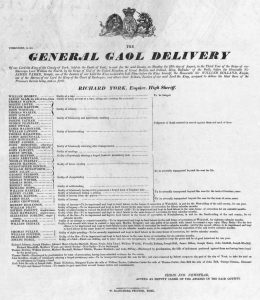
City of York Prison Calendar showing Henry’s sentence of death
Unfortunately, the warning wasn’t enough, and in a few months later he was in trouble again. 15 year old Henry Aldred and 19 year old John Hincliff were charged on oath, that they on the 7th of August 1832 in Leeds, did break and enter the dwelling house of Benjamin Wheelhouse, and feloniously steal 2 sovereign pounds of silver coin, 10 pounds of raw sugar, one hat, and 15 pounds bacon. (City of York Prison Calendars).
At the Summer York Assizes, Henry was convicted of housebreaking in York on 27 August 1832, found guilty, and he was sentenced to death.
Fortunately in November 1832, a petition was made on his behalf, pleading for mercy, and his sentence of death was commuted to life transportation beyond the seas.
Henry was transferred from York Prison to the Prison Hulk Ship “Euryalus” on 5 November 1832, which was moored in Chatham, Kent, England to await transportation to Australia.
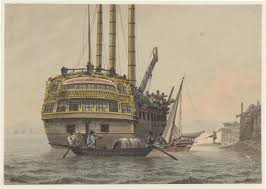
Prison hulks were decommissioned warships, stripped of their masts, rigging and sails. Hulks were moored up along the Thames and Medway estuaries, as well as at Portsmouth, Bermuda and Gibraltar.
In these locations, the work of convicts increased the efficiency of dockyards. Convicts provided a cheap and efficient workforce, and rather than build new barracks to house men, prison hulks could be acquired at little cost and towed from site to site.
In November 1832 James is recorded aboard the Prison Hulk “Euryalus” on the Prison Registers. The Surgeons Report describes him as healthy and orderly.
For a considerable period, youths as young as eight who were sentenced to transportation were kept in hulks alongside adult prisoners. Boys between 11 and 19 accounted for up to 10% of the prisoners. They lived in the same atrocious conditions as the men, although, inevitably, they faced additional dangers because of their youth.
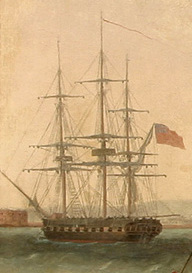
prison hulk “Euryalus” ca 1803
Around 1825, the “Euryalus” at Chatham became a hulk solely for young boys. Here the regime was especially severe. Boys aged no more than 14 were kept below deck for 23 hours a day and forced to do manual labour. They lived in constant fear of physical abuse from the guards and a culture of gang violence was embedded.
The Prison Hulk Register dated 3 December 1832 states that Henry,aged 15, has been in prison three times before, and acquitted, and is of bad character, and he should be sent to Van Dieman’s Land or as we know it, Tasmania. (National Archives HO 9/2).
Henry was transferred to the convict transportation ship “John” which left England on 3 August 1833 for Van Dieman’s Land. The ship was carrying 261 passengers and it arrived in Tasmania on 1st December 1833. (Convict Transportation Registers -National Archives UK Ref HO 11/9).
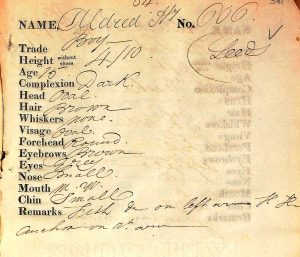
Convict Indent – Henry Aldred 1832
According to the convict indent, Henry was only a boy, aged 15, dark complexion, brown hair, no whiskers, brown eyebrows, grey eyes, and had a tattoo of an anchor on his right arm, and a fish on his left arm.
Once reaching Hobart, Tasmania, the prisoners were assigned to either government duties or to private masters.
Henry was assigned to Mr A Taylor of Macquarie (near current day Strahan).
The Macquarie Harbour Penal Station was established on Sarah Island in Macquarie Harbour, housing mainly male convicts. During its 11 years of operation, the penal colony achieved a reputation as one of the harshest penal settlements in the Australian colonies.
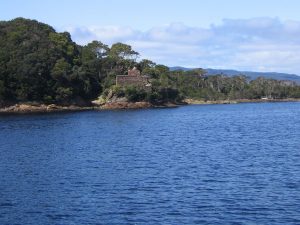
Sarah Island penal settlement ruins
It was separated from the mainland by treacherous seas, surrounded by a mountainous wilderness and was hundreds of miles away from the colony’s other settled areas.
In 1834 Henry’s conduct record (Tasmanian Archives) states several offences for which he was given lashes for various reasons including neglect of duty (25 lashes), destroying his master’s property, absent without leave (48hrs solitary confinement), disobeying orders (2 days solitary confinement), etc.
In 1836 he was cited for disorderly conduct and fighting, absent without leave (sent to Bridge chain gang), absent without leave (sent to Sandy Bay).
In 1838 he was out after hours late and more neglect of duty (25 lashes and hard labour for six months), r (10 days in a cell).
In 1839 he was reported for insolence and quitting his master’s service without leave (14 days hard labour), disobedience of orders and neglect of duty.
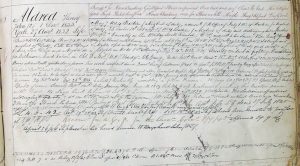
Convict Conduct Record – Henry Aldred
In 1840 he is again absent without leave and drunk (3 months hard labour), committing a crown felony (discharged).
1841 Assault case dismissed, 1842 and 1843 drunk and disorderly and absent without leave.
It seems Henry was a bit of a rebel, and was again in trouble and on 16 April 1844 as he was sentenced to 10 days in the House of Correction, hard labour, for misconduct and neglect in his hired services.
Amazingly, after such a colorful report, the next time we hear of Henry is when he was given a Ticket of Leave on 1 June 1844.
These was sometimes offered as a reward to convicts for good behaviour (ha!) or for exchange of information that would lead to the apprehension of somebody for a crime. They were required to carry it on their person at all times. It also allowed them to work for themselves (instead of the government or a master) provided they remained in a specified area, reported to local authorities regularly, and attended worship on Sundays.
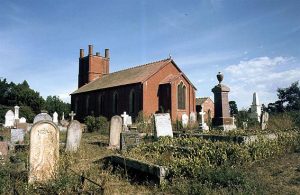
St Lukes Campbelltown Tasmania
Henry could now apply for Permission to Marry which he did on 17 May 1844 in Campbelltown, Tasmania. Permission was approved for him to marry Miss Margaret Agnew. Click on her name to read more about her.
Margaret was born in 1820 in Belfast, Northern Ireland, the daughter of James Agnew.
Like Henry, Margaret was also a convict. At the age of 18 she was convicted of larceny (theft) and sentenced to transportation for seven years across the seas.
Henry and Margaret were married on 17 June 1844 in Campbelltown, Tasmania, both aged 26 years. Henry was described as a house servant. Neither Henry or Margaret could write, given they signed their mark with an ‘x’. Their witnesses John and Mary Wilson did likewise.
Before the following year was up they had started their family of four children –
- George b 1845 Campbelltown, Tas d 1918 Violet Town marr *Kate White
- Elizabeth b 1850 Launceston, Tas d 1928 Violet Town marr ^Thomas Ramage
- Margaret b 1853 Benalla, Vic d 1936 Wangaratta marr #Abel White
- Ann b 1855 Violet Town, Vic d 1940 Violet Town marr ^James Ramage
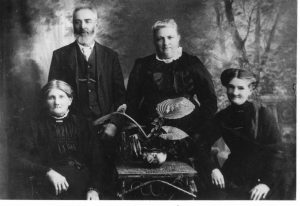
George Aldridge and sisters Margaret (standing beside George) Elizabeth (sitting in front of George) Annie (sitting beside Margaret)
*Kate’s parent’s Richard White and Emma Smith are my 3 x great grandparents.
# Abel White is Kate’s cousin – their father’s Richard and William were brothers.
^ James and Thomas Ramage were brothers – two brothers married two sisters.
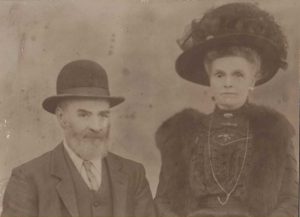
George Aldridge and Kate White
George’s birth registration on 31 May 1845 appears under the name “Aldridge”, the first time I’ve noticed the change from Aldred to Aldridge.
Given that Henry and Margaret appear to be both illiterate, perhaps it was the clerk’s hearing error, or perhaps it was a deliberate attempt by Henry to start a new life under a slightly different name.
Henry was recommended for a Conditional Pardon on 4 July 1845. On 28 September 1846, the Conditional Pardon was extended to include a condition that he could reside anywhere withing the Australian Colonies. (National Archives UK Ref HO 10/59).
Henry appears on the 1846 Tasmania Convict Muster, confirming he was a Ticket of Leave convict, sent to Tasmania for life aboard the “John” from York in 1833. (National Archives UK HO 10/38).
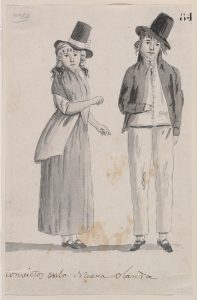
Convicts in Australia
Now that Henry had his Pardon, he could leave Tasmania if he wanted to, and that’s exactly what he did, travelling to Melbourne, Victoria with Margaret, sometime between 1850 and 1853. Perhaps they changed their surname for a new start, as in Victoria it appears only as “Aldridge”.
Their daughter Margaret was born in Benalla in 1853, but Henry and Margaret decided to make Violet Town their home, and in June 1857, Henry Aldridge, residing in Tulip Street, a bushman, appears in a survey of the town by Mrs Hoskins of the Violet Town General Store).
Henry’s wife Margaret was a very colorful character, appearing more than once in the Violet Town Police Court, and spending a little time in the Beechworth Gaol. Read more about her colorful life here.
By 1870 Henry has moved to nearby Boho, and is working as a wood splitter. He appears in an early directory for the area.
Henry’s son George Aldridge appears on the Victorian Crown Land Grant register for Boho in 1875, having his applications for leases approved.
Henry died on 1st June 1893 in Violet Town, aged 77 years and his wife Margaret died on 25 August 1897 aged 77 years.
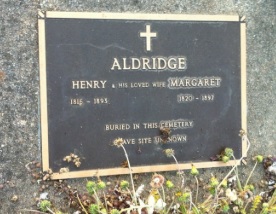
Violet Town Cemetery
They were both buried in the Violet Town Cemetery in an unknown location, but this plaque marks their burial in the cemetery.
Henry’s will was probated on 30 August 1893 by Thomas Ramage, husband of Henry’s daughter Elizabeth.
He was described as a farmer of Boho.
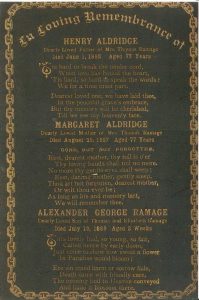
Henry and Margaret Aldridge Memorial Card
The affidavit by Thomas records that Henry died at Thomas’s house at Boho, having resided there for the last week of his life.
Thomas also stated that Henry had always entrusted him with his money to pay debts, rates and rents.
So there you are – two of Violet Town’s most colorful characters, remembered by their descendants.

